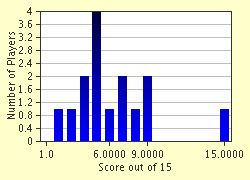Quiz Answer Key and Fun Facts
1. In which century did Thomas Gainsborough produce his artistic masterpieces?
2. Gainsborough was considered by his eminent fellow-artist and contemporary Sir Joshua Reynolds to be a bad model for students at the Royal Academy. What was Gainsborough's main artistic limitation, in Reynolds's opinion?
3. What class of people did Gainsborough, who hardly ever read a book himself, generally avoid portraying in his art?
4. Which one of these seventeenth-century Dutch artists influenced Gainsborough the most in his paintings and drawings of landscape scenes?
5. Where would one go to see the original of one of Gainsborough's most celebrated paintings, "Mr and Mrs Robert Andrews"?
6. In Gainsborough's well-known portrait of his two young daughters in London's National Gallery, what are the two little girls chasing?
7. What was Gainsborough's reported attitude towards the beautiful young women who sat for him throughout his career?
8. Which one of these things is *not* happening in Gainsborough's beautiful (and canine-free) oil-painting "The Harvest Waggon"?
9. Which one of these statements is *not* true of Gainsborough's most famous painting, the iconic portrait universally known as "The Blue Boy"?
10. Which one of these titles refers to an atmospheric seascape by Gainsborough, first exhibited at the Royal Academy in 1781?
11. What was the location of the famous social scene, now part of the Frick Collection in New York, which Gainsborough painted in the early 1780s, depicting what seems likely to have been a typical view from his studio in London?
12. Gainsborough "went to great lengths to conjure up the effects of dreaminess and unreality in his art", writes Andrew Graham-Dixon. Which one of the following is *not* characteristic of the painting methods he used in an attempt to achieve magical, phantasmagorical effects on the canvas?
13. In his later years Gainsborough also developed an interest in the then fashionable taste for so-called "fancy pictures", or "fancy pieces". Which one of the following descriptions does *not* give an accurate account of Gainsborough's productions in this genre?
14. Towards the end of his life, Gainsborough produced his one and only painting of a subject from classical mythology. What was the story, involving a goddess and a hunter, which he used for this very beautiful work?
15. What delicate compliment did a younger - and greater - Suffolk-born artist, John Constable, bestow on Gainsborough, whose landscapes served him in his early days as inspiration for his own?
Source: Author
londoneye98
This quiz was reviewed by FunTrivia editor
bloomsby before going online.
Any errors found in FunTrivia content are routinely corrected through our feedback system.

